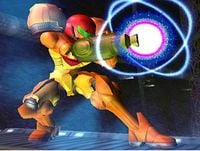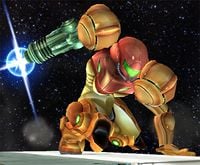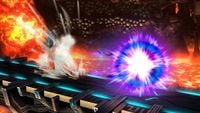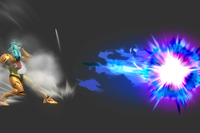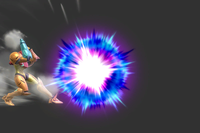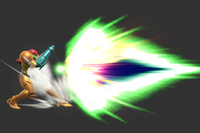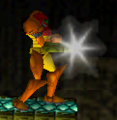Charge Shot
| Charge Shot | |
|---|---|
{{{content1}}}
{{{content2}}} Charging and firing the attack in Ultimate. | |
| Users | Samus Dark Samus |
| Universe | Metroid |
| Article on Metroid Wiki | Charge Beam |
Charge Shot (チャージショット, Charge Shot) is Samus and Dark Samus's neutral special move.
Overview
Pressing the special move button will cause Samus to start auto-charging energy in her arm cannon, which can be fired by pressing the button again. The move starts off as a tiny weak projectile but as it is charged, it becomes bigger and stronger. When the attack has reached maximum strength, Samus will stop charging and resume her neutral standing position, but her arm cannon will start to flash. Pressing the special move button in this state will let her fire the fully charged shot. While charging, the player can press the grab or shield button or the control stick left or right to cancel the charge and/or dodge or roll, and pressing the special move button again will resume her charge. This is called charge-canceling. If Samus is hit while she's charging, she will drop all the stored charge.
In games prior to Ultimate, the move could only be charged when used on the ground. When used in the air, Samus would instantly fire, whether the beam was previously charged or not; thus, the move cannot be charged in the air. A fully charged shot deals very high damage and solid knockback for a projectile, being a solid KO move.
In Super Smash Bros.
In Super Smash Bros., Samus' Charge Shot works on a stage system. The Charge Shot has eight different stages as it charges, with each stage being larger and dealing more damage and knockback than the last. The amount of startup the move has before it starts charging or before Samus shoots depends on the level of charge. With no charge, the move takes 15 frames to startup which then increases up to 19 frames as the move reaches higher charge levels. The whole move takes 155 frames (Just under 2.6 seconds) to fully charge. When Samus shoots her Charge Shot, it comes out on frame 2 and the entire animation takes 30 frames. When used in the air, Samus will not go into her charge animation and when she shoots her Charge Shot, she will perform a small jump.
A fully charged Charge Shot is incredibly powerful, dealing 26% and very high horizontal knockback, KOing Mario at 70% on Dream Land, making it Samus' strongest KO move. Samus is also capable of comboing into Charge Shot with down aerial being her strongest setup. This naturally makes a fully charged Charge Shot deadly as it is a large and very powerful projectile which can catch opponents landing, edgeguard opponents and end combos for early KOs. It only real downside is that its hitbox is deceptively small, making the Charge Shot easier to avoid than what the projectile suggests.
Charge Shot is also very effective against shields, especially the fully charged version. Samus can land a guaranteed charge shot on shield after a Z-canceled neutral, back or down aerial, with the entire string leading into a forward smash for a shield break combo. The fully charged version gives Samus an enormous frame advantage on shield (+30 frames at point blank) which easily allows her to pressure her opponents. The move can easily lead into her grab which then allows her to use her incredibly powerful throws. Samus even has a shield break combo from a fully charged Charge Shot with Charge Shot → upward angled forward smash → forward tilt although this is very difficult to perform and it also only works against a few characters.
Charge cancel
Samus is capable of cancelling her charge shot with a roll or shield. With the shield variant, Samus is stuck in lag for one frame before she can shield. If Samus only presses shield for one frame, she will not go into the shielding animation, enabling her to immediately act out of the charge (known as Charge Storage Canceling). This is very difficult to perform and utilise however due to the frame perfect timing required although the normal shield variant is still very useful as Samus can not only shield attacks but she can also jump out of shield which can then lead into her aerials or her Screw Attack.
Overall, Charge Shot is a very powerful tool in Samus' kit due to its extreme power and range, in addition to its incredible shield pressuring potential.
In Super Smash Bros. Melee
In Super Smash Bros. Melee, Charge Shot has seen numerous changes. One positive change the move has received is that it takes less time to startup. The move always takes 13 frames to startup, which is two frames less than its non charged counterpart in the previous game and six frames less than its previous fully charged counterpart. The move also charges faster, taking half a second less to fully charge. Samus has also gained a new notable setup into the move with her new down throw .This down throw + Charge Shot combo is highly effective against numerous members of the cast.
The aerial version has seen a change where Samus now just continues to drop after using it. In the previous game, Samus would perform a small jump when shooting her aerial Charge Shot but now, it no longer affects her vertical momentum. This can be a positive or negative thing depending on the situation.
However, the move has also seen some negative changes. The move's power has been reduced with the move dealing less knockback and some levels even deal less damage (including the fully charged version which now deals 25%). The lower levels saw the largest reduction to their power although every level was made weaker. A fully charged Charge Shot still remains incredibly powerful however, only KOing around 10% later from center stage and as it is a more base knockback oriented move now, it can even KO slightly earlier if the opponent is very close to the horizontal blastzone.
The move is also less effective on shields. Not only does the move no longer deal extra shield damage (except for the fully charged version which deals more) but the move is heavily hindered by the changes to shields. Samus not only now has no ways to set up a Charge Shot on shield now but the fully charged version no longer gives Samus the frame advantage on shield if she lands it at point blank range. This means that the inescapable grab and shield pressure setups she used to have are gone, although the move does not leave Samus at a large disadvantage (-5 frames to be exact), with the move still being safe on shield overall.
The projectile also no longer has an infinite duration, now lasting for 70 frames before it disappears and the charge cancel animation has been made longer, going from one frame to eight frames. This makes it much riskier for Samus to cancel the charge shot although this also has a positive effective, as it is much easier for Samus to cancel the move without going into shield due to this longer animation. One last change which was not made to the move but still hinders it is that when Samus is hit out of her Screw Attack, she will lose the charge for her Charge Shot, which naturally hurts both Screw Attack and Charge Shot.
Overall, Charge Shot still remains a very powerful tool in Samus' kit as while it isn't as rewarding when it lands, the fully charged version is still a very powerful KO move and the reduced startup lag and reduced charge time were useful changes.
In Super Smash Bros. Brawl
In Super Smash Bros. Brawl Charge Shot has seen multiple changes although the move has been noticeably toned down overall. One positive change is that the projectile has a larger hitbox, regardless of the charge level. This is especially the case for the fully charged version. Another positive change is that the move now has an instant charge cancel animation which makes it much safer to cancel the charge (although Samus can no longer perform Charge Cancel Storage due to this).
A minor change with the move is that the higher levels have a different launch angle, now launching opponents at a 40° angle rather than the Sakurai angle. This makes the higher levels launch aerial opponents at a lower angle although considering the changes to the Sakurai angle, they launch grounded opponents at a higher angle than if the move kept the Sakurai angle (although the angle is still lower than in the previous game).
However, the move has seen rather significant nerfs. Two minor nerfs are that it takes Samus one frame longer to shoot her Charge Shot and the projectile lasts for one less frame. These changes do not hurt the move too much however and the higher startup lag acts as a double edged sword as it gives the move one frame less ending lag.
A more substantial nerf however is that the higher charge levels deal less knockback, with the fully charged version taking a rather drastic hit. In Melee, the fully charged version was a very reliable KO move under 100% even for center stage but in Brawl, it cannot even KO most characters at 100% from center stage unless they have poor DI. This is made even worse when considering the move's very high hitlag, as it makes it very easy for the opponent to DI/SDI the move to survive it for as long as possible. The move has gone from being Samus strongest KO move by a large margin (outside of her charged Smash attacks) to its power now being similar to her up angled forward smash and her back aerial, which both had their power reduced from Melee as well. The reduced power of the fully charged version does have one positive effect however, as it can now lead into followups at very low percents (most notably dash attack and down tilt) although even these followups can be avoided with SDI. A fully charged Charge Shot also travels slower which overall makes it easier to avoid despite its larger hitbox.
Overall Charge Shot still remains a useful tool in Samus' kit despite the rather drastic nerfs to her fully charged Charge Shot. While her fully charged Charge Shot is far less rewarding, it is still a strong projectile which is large, deals a lot of damage, can lead to followups at very low percents, can KO at high percents and it still remains very safe on shield, still making it a solid move overall.
In Super Smash Bros. 4
In Super Smash Bros. 4, Charge Shot has seen multiple positive changes. The move no longer uses a stage system, now having a charge formula for its power. This means that the move is constantly getting larger and more powerful and not just after every 1/4 of a second. The move's launch angle still changes to 40° once its charge reaches a certain point. The projectile also has larger hitboxes, especially when it is fully charged. The move also benefits from the universal increase to shield damage, with the fully charged version now dealing a chunky amount of shield damage. A strong stray hit into a fully charged charge shot can lead into a shield break although Samus' only guaranteed setups into this are with either Bomb into Charge Shot or vice versa (which can be very difficult to set up due to Bomb's slow speed) or with Super Missiles into Charge Shot, which only works from far distances, which is highly telegraphed and easily avoidable in most situations.
A fully charged Charge Shot has received a reduced hitlag multiplier, with the move having 2/3rds the amount of hitlag. One the one hand, this makes the move harder to DI/SDI, especially with the weakening of the mechanics however, it also increases the ending lag of the move on hit, as the opponent is put into hitstun/shieldstun sooner.
Around a year before the game came out on 3DS, Masahiro Sakurai posted a Miiverse post stating that Charge Shot had "drastically improved" speed and power. While there is some truth to this statement in the final game, the overall improvements in the final aren't quite as significant as the statement makes them out to be. This suggests that Sakurai either overestimated the changes made or the move was toned down at some point before release.
In terms of power, the move did receive more KO power as Sakurai stated. With the new way the charge functions, the move is overall stronger as its charge increases, even though the uncharged version retains its power from the previous two games. The fully charged version also received an increase to its power. The fully charged version overall KOs around 15% earlier than its Brawl counterpart which while not quite "drastically improved" (and still far weaker than its Smash 64 and Melee counterparts), it is still nevertheless a noticeable improvement and additional universal factors such as the weakening of DI/SDI/hitstun canceling and the introduction of rage also help it KO sooner/more reliably.
In terms of speed, however, Sakurai's statement was only partially true. The area where the move saw an improvement to its speed was the speed of the projectile. The projectile travels 20% faster than it did in Brawl regardless of the charge level which overall makes it easier to land, especially considering its larger size.
The speed of the actual move, on the other hand, was not improved. The move retains the same startup lag and charge time as in the previous game. Moreover, the move's ending lag was noticeably increased, which causes the move to be even more exploitable. The uncharged version received 10 frames more ending lag while the fully charged version received an even higher 17 frames more ending lag. This greatly reduces the safety of the move as it makes the uncharged version more punishable on hit and whiff (and on shield to a lesser extent) and the fully charged version in particular has become a lot more punishable. In can no longer lead into followups on hit, it is a lot more whiff punishable and the move has now become very unsafe on shield (if it doesn't break the shield). In Brawl the fully charged version was only potentially punishable on shield by Mario with Super Jump Punch and even this only worked at close range. On power shield, more characters could punish the move but even they could only punish if they had a very quick neutral attack or tilt, which usually did not grant a significant reward. In Smash 4 however, the move is far more punishable on shield, with some characters even being able to hit Samus with smash attacks. The situation is even worse on power shield due to power shielding now reducing the amount of shieldstun the opponent takes.
Overall, Charge Shot is a higher risk higher reward move, with the move still being a strong tool in Samus' kit. The move is stronger, easier to land and it can even potentially cause a shield break for a big punish however, the move has more ending lag so if Samus either misses it or if the opponent shields it without having their shield broken, she is more vulnerable to being punished. Nevertheless, it still remains a key move for Samus and it noticeably benefits from the game's universal changes.
In Super Smash Bros. Ultimate
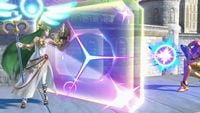
In Super Smash Bros. Ultimate, Samus can now charge her shots in midair. This can be cancelled by jumping or air dodging. Additionally, Dark Samus, being an Echo Fighter of Samus, retains this move; compared to Samus, Dark Samus's version is fired at a slightly lower elevation, allowing her to hit grounded targets that Samus cannot.
Instructional quotes
| Hold | ||
| Charge with the B Button and press again to fire. Press the Z Button to stop charging and resume later with the B Button. | ||
| Charge energy, and fire a shot with | ||
| Charges up a projectile while on the ground or in midair. Can keep the charge after dodging or shielding. | ||
| Charges up a projectile while on the ground or in midair. Can keep the charge after dodging or shielding. |
Customization
Special Move customization was added in Super Smash Bros. 4. These are the variations:
| 1. Charge Shot | 2. Dense Charge Shot | 3. Melee Charge Shot |
|---|---|---|
| "An energy ball that shoots straight. Can be charged and stored for later." | "A Charge Shot with even more power, but at the expense of range and speed." | "A point-blank Charge Shot that isn't a projectile. Charging expands its range." |
- Charge Shot: Default.
- Dense Charge Shot: Takes 30% longer to charge, but fires a larger, more powerful and much slower-moving projectile. 4% uncharged, 27% fully charged. The projectile moves so slow that Samus can walk by a fully charged one. There can be up to three uncharged shots on-screen at once. Useful for setups.
- Melee Charge Shot: Releases a short-range "shotgun blast" of energy rather than a projectile ball, meaning the attack can neither be reflected nor absorbed. Deals 5% damage uncharged and 20% fully charged. The move has plenty of hitstun, but high ending lag. Charges faster than the original move. Much like Mewtwo's Shadow Ball, this move slides Samus backward depending on how much it was charged, therefore making it potentially useful for recovering back on-stage.
Origin
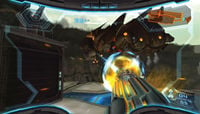
If she didn't start out with it, the Charge Beam was one of the first power-ups Samus would get in the Metroid games, starting with Super Metroid. A fully charged Beam's shot would become Samus's only way of damaging certain bosses should she run out of missiles. In Metroid Prime, Charge Beams can be used to clear debris blocking Samus's path or to suck in nearby Energy Balls and Ammo Energy, as well as being the starting point for Charge Combos. In the Metroid series, Samus cannot save a charge for later as she can in Smash Bros., though she can continue charging and just hold it for any length of time, as well as begin charging while in motion and in the air. In the Metroid games, the beam also charges noticeably faster.
Gallery
Samus in the process of charging her arm cannon in Super Smash Bros. Brawl.
Villager pockets a Charge Shot in Super Smash Bros. for Wii U.
Samus in the process of charging her arm cannon in Super Smash Bros. for Nintendo 3DS.
Samus shooting a fully charged blast in Super Smash Bros. for Wii U.
Samus in the process of charging her arm cannon in Super Smash Bros. for Wii U.
Palutena reflecting the attack in Ultimate.
Samus using Charge Shot as shown by the Move List in Ultimate
Dark Samus using Charge Shot as shown by the Move List in Ultimate
Names in other languages
Trivia
- When Kirby uses this move, he uses his hands to charge and fire the shot, since he has no Arm Cannon of his own.
- The charging sound for the Melee Charge Shot is shared with the Mii Gunner's Charge Blast.
- This move shares its name with Mega Man's forward smash.

